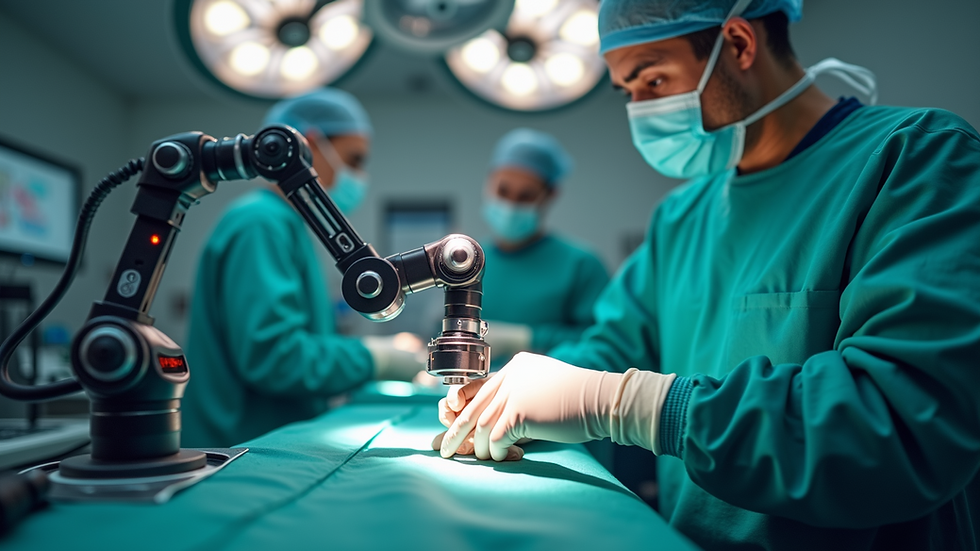Acute Care Surgery: Innovations and Trends
- danlimsf
- 5 days ago
- 5 min read
Acute care surgery is a rapidly evolving field that plays a crucial role in saving lives. It encompasses a range of surgical procedures performed on patients with urgent medical conditions. As technology advances and new techniques emerge, the landscape of acute care surgery is changing. This blog post will explore the latest innovations and trends in this vital area of medicine.
Acute care surgery is not just about performing operations. It involves a comprehensive approach to patient care, including diagnosis, treatment, and post-operative management. Surgeons in this field must be prepared to handle a variety of emergencies, from traumatic injuries to complex abdominal conditions.
In recent years, several key innovations have transformed how acute care surgery is practiced. These advancements not only improve patient outcomes but also enhance the efficiency of surgical teams. Let’s take a closer look at some of these exciting developments.
Minimally Invasive Techniques
One of the most significant trends in acute care surgery is the shift towards minimally invasive techniques. Traditional open surgery often requires large incisions, leading to longer recovery times and increased pain for patients. In contrast, minimally invasive procedures use smaller incisions, resulting in less trauma to the body.
Benefits of Minimally Invasive Surgery:
Reduced Pain: Smaller incisions mean less tissue damage, leading to less pain post-surgery.
Shorter Recovery Times: Patients can often return to their normal activities more quickly.
Lower Risk of Infection: Smaller wounds reduce the risk of post-operative infections.
Surgeons are increasingly using laparoscopic techniques for various procedures, including appendectomies and cholecystectomies. These methods allow for greater precision and control, which can lead to better outcomes.
Enhanced Imaging Technologies
Imaging technologies have also seen significant advancements. High-definition cameras and 3D imaging provide surgeons with better visualization of the surgical site. This enhanced clarity allows for more accurate diagnoses and improved surgical planning.
Key Imaging Innovations:
3D Imaging: Offers a more realistic view of the anatomy, helping surgeons navigate complex structures.
Intraoperative Ultrasound: Allows for real-time imaging during surgery, enabling immediate adjustments to the surgical plan.
These technologies not only improve surgical precision but also enhance the training of new surgeons. With better visualization, trainees can learn more effectively and gain confidence in their skills.
Robotics in Surgery
Robotic-assisted surgery is another exciting trend in acute care surgery. Robotic systems provide surgeons with enhanced dexterity and precision. These systems allow for complex procedures to be performed with greater accuracy and control.
Advantages of Robotic Surgery:
Precision: Robotic arms can make intricate movements that are difficult for human hands.
Reduced Recovery Time: Patients often experience less pain and quicker recovery with robotic procedures.
Improved Outcomes: Studies have shown that robotic surgery can lead to fewer complications and better overall results.
Robotic systems are being used for various procedures, including hernia repairs and gastrointestinal surgeries. As technology continues to advance, we can expect to see even more applications in acute care surgery.
Telemedicine and Remote Consultations
The rise of telemedicine has transformed how healthcare is delivered, including in acute care surgery. Surgeons can now consult with patients remotely, providing timely advice and guidance. This is especially beneficial in emergency situations where immediate care is needed.
Benefits of Telemedicine:
Accessibility: Patients in remote areas can receive expert advice without traveling long distances.
Efficiency: Surgeons can quickly assess a patient’s condition and determine the best course of action.
Continuity of Care: Follow-up consultations can be conducted easily, ensuring patients receive ongoing support.
Telemedicine is becoming an integral part of acute care surgery, allowing for faster decision-making and improved patient outcomes.
Patient-Centered Care
In recent years, there has been a growing emphasis on patient-centered care in acute care surgery. This approach focuses on the needs and preferences of patients, ensuring they are active participants in their treatment plans.
Key Aspects of Patient-Centered Care:
Informed Decision-Making: Patients are provided with all necessary information to make informed choices about their care.
Personalized Treatment Plans: Surgeons consider individual patient needs and preferences when developing treatment plans.
Enhanced Communication: Open lines of communication between patients and healthcare providers foster trust and collaboration.
By prioritizing patient-centered care, surgeons can improve satisfaction and outcomes for their patients.
Data-Driven Decision Making
The use of data analytics is becoming increasingly important in acute care surgery. By analyzing patient data, surgeons can identify trends and make informed decisions about treatment options.
How Data Analytics is Used:
Predictive Analytics: Helps identify patients at risk for complications, allowing for proactive interventions.
Quality Improvement: Data can be used to assess surgical outcomes and identify areas for improvement.
Resource Allocation: Understanding patient needs can help hospitals allocate resources more effectively.
Data-driven decision-making is enhancing the quality of care in acute care surgery, leading to better patient outcomes.
Education and Training Innovations
As the field of acute care surgery evolves, so too does the education and training of surgeons. New training methods are being developed to ensure that surgeons are equipped with the skills needed to succeed in this dynamic environment.
Innovative Training Approaches:
Simulation Training: Surgeons can practice procedures in a controlled environment, allowing for skill development without risk to patients.
Interdisciplinary Training: Collaboration with other healthcare professionals enhances teamwork and communication skills.
Online Learning Platforms: Surgeons can access educational resources and training modules at their convenience.
These innovations in education and training are essential for preparing the next generation of acute care surgeons.
The Future of Acute Care Surgery
Looking ahead, the future of acute care surgery is bright. With ongoing advancements in technology and a focus on patient-centered care, we can expect to see continued improvements in surgical outcomes.
Key Trends to Watch:
Artificial Intelligence: AI has the potential to revolutionize surgical planning and decision-making.
Wearable Technology: Devices that monitor patient health can provide valuable data for surgical teams.
Personalized Medicine: Tailoring treatments to individual patients will become increasingly important.
As these trends continue to develop, acute care surgery will become even more effective and efficient.
Embracing Change in Acute Care Surgery
The innovations and trends in acute care surgery are reshaping the landscape of this vital field. From minimally invasive techniques to the integration of telemedicine, these advancements are improving patient care and outcomes.
Surgeons must embrace these changes and continue to adapt to the evolving healthcare environment. By staying informed and open to new ideas, they can provide the best possible care for their patients.

As we move forward, it is essential to keep the focus on patient-centered care and the use of data-driven decision-making. By prioritizing these elements, acute care surgery can continue to thrive and evolve, ultimately benefiting patients and healthcare providers alike.
In this ever-changing field, the commitment to innovation and excellence will pave the way for a brighter future in acute care surgery.


Comments